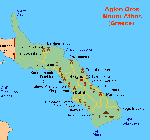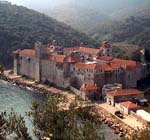Chalkidiki - Mount Athos
Mount Athos - General
 Mount Athos is a mountain and peninsula in Greece. A World Heritage Site and autonomous polity in the Hellenic Republic, Athos is home to 20 stavropegial Eastern Orthodox monasteries under the direct jurisdiction of the patriarch of Constantinople.
Mount Athos is a mountain and peninsula in Greece. A World Heritage Site and autonomous polity in the Hellenic Republic, Athos is home to 20 stavropegial Eastern Orthodox monasteries under the direct jurisdiction of the patriarch of Constantinople.
Today Greeks commonly refer to Mount Athos as the "Holy Mountain"
Mount Athos - Access & Organization
T he number of daily visitors to Mount Athos is restricted, and all are required to obtain a special entrance permit valid for a limited period.
Only males are permitted to visit the territory, which is called "Garden of the Virgin" by the monks, with Orthodox Christians taking precedence in permit issuance procedures.
Residents on the peninsula must be males aged 18 and over who are members of the Eastern Orthodox Church, and must be either monks or workers.
 The Holy Mountain is governed by the "Holy Community which consists of the representatives of the 20 Holy Monasteries, having as executive committee the four-membered "Holy Administration".
The Holy Mountain is governed by the "Holy Community which consists of the representatives of the 20 Holy Monasteries, having as executive committee the four-membered "Holy Administration".
The number of daily visitors to Mount Athos is restricted, and all are required to obtain a special entrance permit valid for a limited period.
In each of the 20 monasteries – which today all follow again the coenobitic system – the administration is in the hands of the Abbot who is elected by the brotherhood for life. He is the lord and spiritual father of the monastery. The Convention of the brotherhood is the legislative body.
All the other establishments (sketes, cells, huts, retreats, hermitages) are dependencies of some of the 20 monasteries and are assigned to the monks by a document called "homologon" .
All persons leading a monastic life thereon acquire Greek citizenship without further formalities, upon admission as novices or monks. Visits to the peninsula are possible for laymen, but they need a special permission (a kind of "visa").
Of the 20 monasteries located on the Holy Mountain, the brethren of 17 are predominantly ethnically Greek. Of the other 3, brethren are drawn from monks of primarily other origins, who become Greek subjects. These are the Helandariou Monastery (Serbian), the Zografou Monastery (Bulgarian) and the Agiou Panteleimonos Monastery (Russian).

